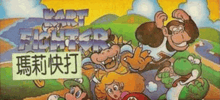Kart Fighter
Kart Fighter (Chinese: 瑪莉快打; pinyin: Mǎ lì kuài dǎ, "Mario Fighter") is an unlicensed 2D fighting game produced for the Nintendo Famicom by Taiwanese studio Hummer Team. The game features unauthorized appearances by Nintendo's mascot Mario and the rest of the cast of Super Mario Kart in a port of Street Fighter II. Kart Fighter has received some media attention, including mostly positive reviews, in part because of its perceived similarity to the later Super Smash Bros. series.
| Kart Fighter | |
|---|---|
 Cartridge art of Kart Fighter | |
| Developer(s) | Hummer Team |
| Publisher(s) | Ge De Industry Co. |
| Platform(s) | Famicom |
| Release | 1993 |
| Genre(s) | Fighting |
| Mode(s) | Single-player, multiplayer |
Gameplay
.gif)
Kart Fighter follows many of the rules and conventions already established for the fighting game genre by the time of its release. The player engages opponents in one-on-one close quarter combat. The object of each round is to deplete the opponent's vitality before the timer runs out. Because it is an adaptation of Street Fighter II,[1][2] the game controls resemble those of the Street Fighter series. The player uses the D-pad to move the character towards or away from the opponent or to jump. The A and B buttons perform punches and kicks, as well as jump punches and jump kicks when combined with movement. Additionally, each character has a selection of special moves performed by inputting a combination of directional and button-based commands. Unlike Street Fighter II, nearly all characters have some form of projectile attack available as a special move,[1] but the blocking system is more limited.[3]
Five difficulty levels are available for solo play.[4] A second player can also select a character, allowing for two-player matches. However, because no indication of this feature appears in game,[3] it can be easily overlooked.[5]
Characters
All eight playable characters from Super Mario Kart appear in Kart Fighter, although several have been renamed or are Japanese versions of names– Mari (Mario), Luigi, Peach (Princess Toadstool), Yossy (Yoshi), Kupa (Bowser), Donkey (Donkey Kong Jr.), Nokonoko (Koopa Troopa), and Kinopio (Toad).[1][6] Many of the characters' appearances are closely adapted from Super Mario Kart sprites, although they are not to scale. However, Donkey Kong Jr. has a substantially different appearance and Princess Peach appears in a miniskirt and boots, similar to Chun-Li from the highly praised Street Fighter II.[3][7]
Development
During the 1980s and 1990s, production of pirate Famicom games in East Asia was commonplace, aided by the Famicom's absence of the 10NES lockout chip included in North American versions of the Nintendo Entertainment System.[8] The commercial success of Street Fighter II made it a particularly frequent choice for unauthorized ports and adaptations.[2] Kart Fighter was one such game, developed by a team known as Hummer Team or Gouder, and published by Hong Kong-based Ge De Industry, probably in 1993.[5][9]
Kart Fighter used character models from the 1992 Super Famicom Super Mario Kart. The use of art from a 16-bit platform on the 8-bit Famicom presented technical challenges, because sprites on the less powerful console were limited to four colors. The Kart Fighter developers overcame this limitation by assembling the characters from several smaller sprites, which move together to give the appearance of a single object.[2] Art resources from other games were also pirated, including a stage background taken from Little Nemo: The Dream Master.[5]
The same development team responsible for Kart Fighter also created other unauthorized Street Fighter II adaptations. One such game was included on the 1998 Super HIK 4 in 1 12M multicart,[5] in which Mario appeared alongside characters from the Street Fighter franchise.[10] The developers also modded Kart Fighter itself to produce the Sailor Moon-themed AV Bishoujo Senshi Girl Fighting.[9][11]
Legacy
Several years after its release, Kart Fighter received critical attention for its similarities to the Super Smash Bros. series.[6] Reviews were generally positive, especially in the context of fighting games on the NES[1] or unauthorized NES games,[2] categories viewed as having typically poor quality. Reviews cited its originality,[2] music,[5] and relative lack of bugs,[3] with several considering it one of the best unauthorized games of its era,[5][7] meeting or exceeding the quality of similar licensed games such as TMNT: Tournament Fighters.[1][2]
However, Complex considered Kart Fighter the worst fighting game ever made.[12] Other reviewers remarked negatively on the screen flicker resulting from the game's sprite system,[2][3] poor AI,[3] missing menu options, and lack of a proper ending.[5]
See also
- Somari, another unlicensed Hummer Team game featuring Mario
References
- Fletcher, JC (2008-04-24). "Virtually Overlooked: Kart Fighter". Joystiq. Retrieved 2013-09-17.
- Kohler, Chris (2003-08-01). "Your Totally Unauthorized Guide to Pirate Famicom Fighters". Insert Credit. Archived from the original on 2011-06-15. Retrieved 2013-09-17.
- Bowen, Kevin. "Game of the Week: Kart Fighter & Strip Fighter II". Classic Gaming. Archived from the original on 2013-09-21. Retrieved 2013-09-17.
- Day, Jeff. "Rated "Arrr!": Kart Fighter". random.access. Archived from the original on 2013-09-21. Retrieved 2013-09-17.
- Gifford, Kevin. "Kart Fighter". |tsr's NES Archive. Retrieved 2013-09-17.
- Yip, Spencer (2006-07-05). "Before Super Smash Brothers there was Kart Fighter". Siliconera. Retrieved 2013-09-17.
- Gestal, Juan (2007-06-05). "Los juegos de lucha piratas de la NES". Pixfans (in Spanish). Retrieved 2013-09-17.
- Wolf, Mark J. P. (2007). The Video Game Explosion: A History from PONG to PlayStation and Beyond. Greenwood. pp. 111–112. ISBN 978-0313338687.
- "Kart Fighter". Universal Videogame List. Retrieved 2013-09-17.
- Gifford, Kevin. "1998 Super HIK 4 in 1 12M". |tsr's NES Archive. Retrieved 2013-09-17.
- "AV Bishoujo Senshi Girl Fighting". Universal Videogame List. Retrieved 2013-09-19.
- Knight, Rich (2011-12-22). "The 10 Worst Fighting Games". Complex. Retrieved 2013-09-19.